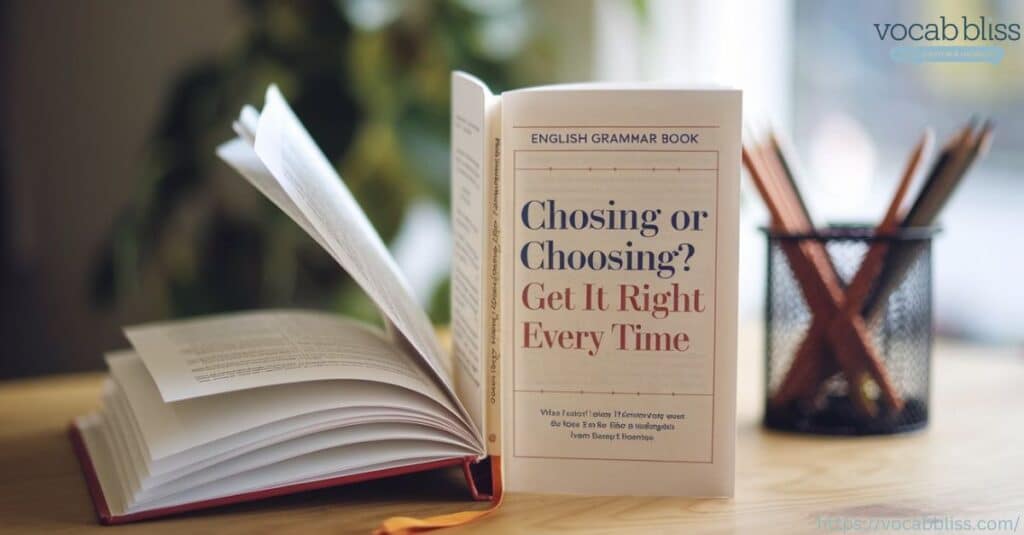When it comes to writing in Standard English, a seemingly small spelling error can make all the difference. One of the most common questions is: “Is it Chosing or Choosing?”
If you’ve ever felt a pang of uncertainty when spelling this word, you’re not alone! Choosing is the correct spelling in formal English, while “chosing” is a common misspelling. So, let’s break down the difference between choosing vs chosing, understand the grammar behind it, and finally conquer this everyday spelling dilemma once and for all.
Understanding the Basics: chosing vs choosing
When we examine choosing and chosing, it’s essential to understand where this common mistake comes from and why spelling accuracy matters.
- Choosing is the present participle form of the verb choose, used in continuous tenses or to describe an ongoing action.
- Chosing, however, is not a recognized word in English and is an incorrect spelling that often results from misunderstanding English spelling rules for present participles.
Why Is Choosing Correct?
In English, verbs that end in a silent “-e,” like choose, drop the “-e” and add -ing to form the present participle. This grammatical rule is straightforward but easy to forget, which is why errors like “chosing” happen. Let’s explore why.
Exploring the McDo menu offers a fun and tasty experience. With options for everyone, you can enjoy meals or snacks anytime. Craving a burger or fries? McDo delivers delicious satisfaction every time. Their menu is packed with variety, ensuring everyone finds something to love.
Definition and Usage
Choosing Definition
Choosing is the present participle of the verb choose. This means it represents an ongoing action, often used in continuous tense structures, like am choosing, was choosing, or will be choosing.
Example: “She is choosing the best option for her team.”

In this sentence, choosing emphasizes that the act of selecting is happening right now.
Grammar Behind Choosing
The process of creating the present participle form (verb + -ing) is essential in English. This “continuous tense” form gives language a sense of immediacy and flow. In Standard English:
- The verb stem of “choose” loses the silent “e” before adding “-ing.”
- The correct spelling is therefore choosing, not “chosing.”
| Verb | Present Participle |
|---|---|
| choose | choosing |
| lose | losing |
| write | writing |
Read More: Tomorrow or Tommorrow: Which One Is Correct?
Chosing or Choosing Meaning
Understanding the difference between “chosing and choosing” is crucial for anyone aiming for precision in their writing. Choosing is the correct term, representing the present participle of the verb choose.
It signifies the act of selecting or making a decision among various options. In contrast, chosing is a common misspelling that arises from misunderstanding English spelling rules.
This simple distinction can enhance your writing clarity and ensure you communicate effectively. Below is a table summarizing the meanings and usage of both terms for clarity.
| Term | Meaning | Usage | Correctness |
|---|---|---|---|
| Choosing | The act of selecting or making a choice among options | “She is choosing her outfit for the party.” | ✅ Correct spelling |
| Chosing | A misspelling of “choosing” that has no recognized meaning | “He is chosing between two movies.” | ❌ Incorrect spelling |
Understanding these distinctions helps improve spelling accuracy and enhances overall communication.
Synonyms for Choosing

When we talk about the act of choosing, we refer to the process of making selections between options or picking a preferred alternative. The term encompasses various nuances, reflecting different contexts and levels of decision-making. Here’s a list of synonyms for choosing that capture its essence:
- Selecting: To carefully pick from a range of options.
- Deciding: To reach a conclusion after consideration.
- Picking: To choose something from a group or collection.
- Opting: To make a choice, often implying a preference.
- Determining: To establish or decide on something after deliberation.
- Electing: To choose by voting or by a formal process.
- Picking out: To select or identify something specific from a larger group.
- Preferring: To favor one option over others.
These synonyms emphasize various aspects of the decision-making process, allowing for a richer vocabulary when discussing the act of making selections. Understanding these alternatives can enhance your writing and communication, making your expressions more precise and varied.

Why “Chosing” is Incorrect
If choosing is right, then why do we see chosing so often? The mistake usually comes from assumptions about spelling rather than applying English spelling rules. Here’s a breakdown of the reasons behind this common misspelling:
- Phonetic Similarity: English is full of words that are pronounced similarly, but have different spellings. Since the sound of “choosing” doesn’t clearly emphasize the second “o,” it’s easy to assume “chosing” would be correct.
- Skipping Grammar Rules: English grammar requires that verbs ending in silent “e” drop the “e” and add “-ing.” However, skipping this rule can lead to mistakes like chosing instead of choosing.
- Typing or Auto-correct Errors: Sometimes, fast typing or auto-correct software changes choosing to chosing, particularly on mobile devices.
“Chosing is a frequent error that results from overlooking subtle language nuances in spelling and grammar.”

Side-by-Side Comparison: Choosing vs. Chosing
A clear side-by-side comparison can help you internalize the distinction between choosing and chosing.
| Aspect | Choosing | Chosing |
|---|---|---|
| Correct Form | ✅ Yes, this is the correct form | ❌ Incorrect spelling |
| Usage | Continuous tense, ongoing action | N/A, not recognized in English |
| Grammar Rule | Drops the “e” and adds “-ing” | Misses grammar rule, keeps the “e” |
Memory Aid: Remember, “choosing” has a double “o” like “choo-choo train.” This helps you remember the extra “o” is necessary!
Everyday Usage Examples of Choosing
Here are some examples of correct usage to help reinforce spelling accuracy and provide clarity in different sentence structures:
- In the Present Continuous Tense: “I am choosing between two universities.”
- In the Past Continuous Tense: “They were choosing the new design when I arrived.”
- In Future Continuous Tense: “Next week, we’ll be choosing our vacation destination.”
Common Phrases with Choosing
- Choosing wisely – emphasizes careful consideration.
- Choosing between options – highlights decision-making.
- Choosing one’s path – implies taking control of one’s direction or choices in life.

FAQ: Choosing vs. Chosing
Why Do People Spell It as “Chosing”?
Most people spell it incorrectly because of phonetic similarity and the tendency to overlook spelling rules. The double “o” in “choosing” might seem unnecessary, especially since other verbs don’t require doubling, which leads to spelling confusion.
Does “Chosing” Ever Appear in Regional Dialects or Informal Writing?
Not typically. In Standard English, chosing is considered an incorrect spelling. However, you might see it in informal settings like texts or social media posts.
How Can I Remember It’s “Choosing” and Not “Chosing”?
Here’s a mnemonic: “You can’t choose without two O’s.” Or think of a “choo-choo train” to remember the double “o” in choosing.
Conclusion
Choosing the correct form of a word is more than a grammar rule; it’s about spelling accuracy and making sure your language flows in a way that communicates clearly. Remember, choosing is the correct form that follows English grammar rules, while “chosing” is a common misspelling. By following these tips, you’ll get it right every time.
- Always drop the “e” and add “-ing” for verbs ending in silent “e.”
- Use memory aids like the “choo-choo train” to reinforce the correct form.
- Practice using choosing in sentences to help internalize the correct spelling.
Whether you’re making selections, picking options, or engaging in decision-making, remembering these language specifics will help you use Standard English confidently.
Now, you’re ready to choose wisely—and spell it accurately every time!







